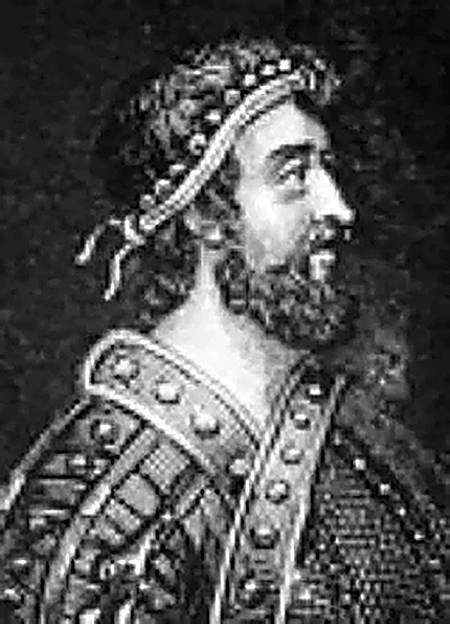



King Harold I Harefoot - Quick Stats




Born: c 1018 AD
Harthacnut: The Last Viking King of England
Harthacnut, also known as Hardicanute, was the last Danish ruler of England, reigning from 1040 to 1042. His life and reign offer a fascinating glimpse into the complexities of medieval kingship, the dynamics of the North Sea Empire, and the transition from Viking to Anglo-Saxon rule in England. The son of Cnut the Great and Emma of Normandy, Harthacnut inherited a vast and powerful empire but struggled to hold it together during his brief and tumultuous reign. His story is one of ambition, familial rivalry, and the challenges of ruling a fragmented realm
Early Life and Lineage
Harthacnut was born around 1018, likely in Denmark. He was the son of Cnut the Great, one of the most successful Viking rulers in history, and Emma of Normandy, a queen of Anglo-Saxon royal lineage. Emmaís marriage to Cnut was a politically strategic union that strengthened ties between England and Normandy and legitimized Cnutís rule over his newly conquered English kingdom. Emma had previously been married to ∆thelred the Unready, the Anglo-Saxon king of England, and her children from that marriage, including Edward the Confessor, would later play a key role in the succession disputes of the time.
Harthacnut was born around 1018, likely in Denmark. He was the son of Cnut the Great, one of the most successful Viking rulers in history, and Emma of Normandy, a queen of Anglo-Saxon royal lineage. Emmaís marriage to Cnut was a politically strategic union that strengthened ties between England and Normandy and legitimized Cnutís rule over his newly conquered English kingdom. Emma had previously been married to ∆thelred the Unready, the Anglo-Saxon king of England, and her children from that marriage, including Edward the Confessor, would later play a key role in the succession disputes of the time.
Harthacnutís early life was shaped by the ambitions of his parents and the vast scope of his fatherís empire, which included England, Denmark, Norway, and parts of Sweden. He was likely raised in a court that blended Danish and Anglo-Saxon traditions, and his upbringing would have prepared him to govern a diverse and multi-ethnic realm.
Relations with Norway and the Treaty with Magnus
Harthacnutís foreign policy was largely shaped by his treaty with Magnus the Good of Norway. This agreement ensured peace between Denmark and Norway during his reign, allowing Harthacnut to focus on his English kingdom. However, the treaty also had long-term implications for the region, as it laid the groundwork for Magnus to inherit Denmark after Harthacnutís death.
Harthacnutís foreign policy was largely shaped by his treaty with Magnus the Good of Norway. This agreement ensured peace between Denmark and Norway during his reign, allowing Harthacnut to focus on his English kingdom. However, the treaty also had long-term implications for the region, as it laid the groundwork for Magnus to inherit Denmark after Harthacnutís death.
Harthacnutís reliance on Danish troops and his detachment from English customs contributed to his unpopularity. He was seen as a foreign ruler who prioritized the interests of his Danish subjects over those of the English people. This perception, combined with his harsh policies, made it difficult for him to build the support he needed to govern effectively.
Cnut the Greatís Empire and the Succession Crisis of 1035
When Cnut the Great died in 1035, he left behind an empire that was impressive in its scope but fragile in its unity. The North Sea Empire depended on the personal authority of its ruler, and without a strong and present king, it was prone to fragmentation. Harthacnut, as Cnutís legitimate son with Emma, was the natural choice to inherit the empire. However, his position was immediately challenged.
When Cnut the Great died in 1035, he left behind an empire that was impressive in its scope but fragile in its unity. The North Sea Empire depended on the personal authority of its ruler, and without a strong and present king, it was prone to fragmentation. Harthacnut, as Cnutís legitimate son with Emma, was the natural choice to inherit the empire. However, his position was immediately challenged.
Children: None
Wife: None
Father: Cnut the Great
Mother: Emma of Normandy
Died: 8th June 1042 AD
From an early age, Harthacnut was positioned as his fatherís heir, particularly in Denmark, where he was named co-king around 1028. However, his position as the preferred heir to the English throne was less secure due to the existence of his half-brother Harold Harefoot, Cnutís son from his earlier marriage to ∆lfgifu of Northampton. This familial rivalry would come to define much of Harthacnutís political struggles.
At the time of Cnutís death, Harthacnut was in Denmark, dealing with threats from Magnus the Good, the ambitious king of Norway. His absence from England created a power vacuum that Harold Harefoot, supported by northern English nobles and the Danelaw, sought to exploit. While Harthacnut was recognized as king in the south of England, his half-brother claimed the north and quickly consolidated his power.
Emma of Normandy, Harthacnutís staunch supporter, worked tirelessly to maintain her sonís claim to the English throne. She remained in Winchester, the center of her power base, and held the royal treasury. However, by 1037, Harold Harefoot had effectively taken control of England, forcing Emma into exile in Flanders and declaring himself king.
Harthacnutís Struggles in Denmark
While Harold Harefoot ruled in England, Harthacnut focused on securing his position in Denmark. This was no easy task, as Denmark faced significant threats from external forces, particularly Magnus the Good of Norway. Magnus sought to capitalize on the instability in the region and posed a serious challenge to Harthacnutís rule.
While Harold Harefoot ruled in England, Harthacnut focused on securing his position in Denmark. This was no easy task, as Denmark faced significant threats from external forces, particularly Magnus the Good of Norway. Magnus sought to capitalize on the instability in the region and posed a serious challenge to Harthacnutís rule.
In response to this threat, Harthacnut negotiated a treaty with Magnus, agreeing that whichever king died first would leave his kingdom to the other. While this agreement secured peace between the two nations, it also limited Harthacnutís ability to focus on reclaiming his position in England. His attention remained divided, and his absence from England during these critical years allowed Harold Harefoot to strengthen his hold on the throne.
While the treaty ensured stability in Scandinavia, it also underscored the limitations of Harthacnutís power. By binding himself to Magnus, Harthacnut effectively ceded some control over the future of his kingdom, a decision that would have significant consequences after his death.
Return to England and Ascension (1040)
Harold Harefootís sudden death in 1040 provided Harthacnut with the opportunity to reclaim the English throne. With a fleet of warships and a substantial force of Danish troops, Harthacnut sailed to England. His arrival was unopposed, as Haroldís death had eliminated the primary obstacle to his ascension. By June 1040, Harthacnut was crowned king, reuniting the English and Danish realms under his rule.
Harold Harefootís sudden death in 1040 provided Harthacnut with the opportunity to reclaim the English throne. With a fleet of warships and a substantial force of Danish troops, Harthacnut sailed to England. His arrival was unopposed, as Haroldís death had eliminated the primary obstacle to his ascension. By June 1040, Harthacnut was crowned king, reuniting the English and Danish realms under his rule.
Harthacnutís return to England was marked by a desire for revenge against those who had supported Harold. One of his first acts as king was to order the exhumation of Harold Harefootís body. In a shocking display of posthumous punishment, Haroldís corpse was mutilated, decapitated, and thrown into a marsh or the Thames. This act symbolized Harthacnutís anger and the deep divisions within the kingdom, but it also alienated many of his subjects, setting the tone for a reign characterized by harshness and discontent.
Predecessor: Harold Harefoot
Successor: Edward the Confessor
The Reign of Harthacnut
Harthacnutís reign in England lasted only two years, but it was marked by significant challenges and controversies. One of the most pressing issues was the need to fund his army and navy, which he relied on to maintain control over his kingdom. To this end, Harthacnut imposed heavy taxation, which was deeply unpopular among his English subjects.
Harthacnutís reign in England lasted only two years, but it was marked by significant challenges and controversies. One of the most pressing issues was the need to fund his army and navy, which he relied on to maintain control over his kingdom. To this end, Harthacnut imposed heavy taxation, which was deeply unpopular among his English subjects.
The rebellion in Worcester in 1041 was a direct result of these burdensome levies. The people of Worcester resisted the collection of taxes, and in response, Harthacnut ordered a brutal reprisal. His soldiers sacked the city, burning it to the ground and further alienating the English population.

Death and the End of Danish Rule in England
Harthacnutís reign came to an abrupt end on June 8, 1042, when he died suddenly at a wedding feast in Lambeth. According to contemporary accounts, he collapsed after drinking heavily and died shortly afterward, possibly from a stroke or heart failure. His death at the age of around 24 marked the end of Danish rule in England and the dissolution of the North Sea Empire established by his father.
Harthacnutís reign came to an abrupt end on June 8, 1042, when he died suddenly at a wedding feast in Lambeth. According to contemporary accounts, he collapsed after drinking heavily and died shortly afterward, possibly from a stroke or heart failure. His death at the age of around 24 marked the end of Danish rule in England and the dissolution of the North Sea Empire established by his father.
With no direct heirs to succeed him, Harthacnutís death paved the way for his half-brother Edward the Confessor to ascend the throne. Edwardís coronation marked the restoration of the Anglo-Saxon dynasty and a significant shift in the political landscape of England.
Legacy of Harthacnut
Harthacnutís legacy is one of complexity and contradiction. His reign was brief and marked by unpopularity, yet it played a crucial role in the transition between Danish and Anglo-Saxon rule. His harsh policies and punitive measures alienated many of his subjects, but his decision to invite Edward the Confessor back to England helped ensure a stable succession after his death.
Harthacnutís legacy is one of complexity and contradiction. His reign was brief and marked by unpopularity, yet it played a crucial role in the transition between Danish and Anglo-Saxon rule. His harsh policies and punitive measures alienated many of his subjects, but his decision to invite Edward the Confessor back to England helped ensure a stable succession after his death.
As the last Viking king of England, Harthacnut represents the end of an era. His story highlights the challenges of ruling a fragmented empire, the difficulties of balancing multiple realms, and the tensions between different cultural and political traditions. While his reign was short and often criticized, Harthacnutís life and legacy remain a fascinating chapter in the history of medieval England.
His death also marked a turning point in English history, as the kingdom shifted its focus from Scandinavia to the continent. This transition would ultimately culminate in the Norman Conquest of 1066, reshaping the political and cultural landscape of England for centuries to come.


